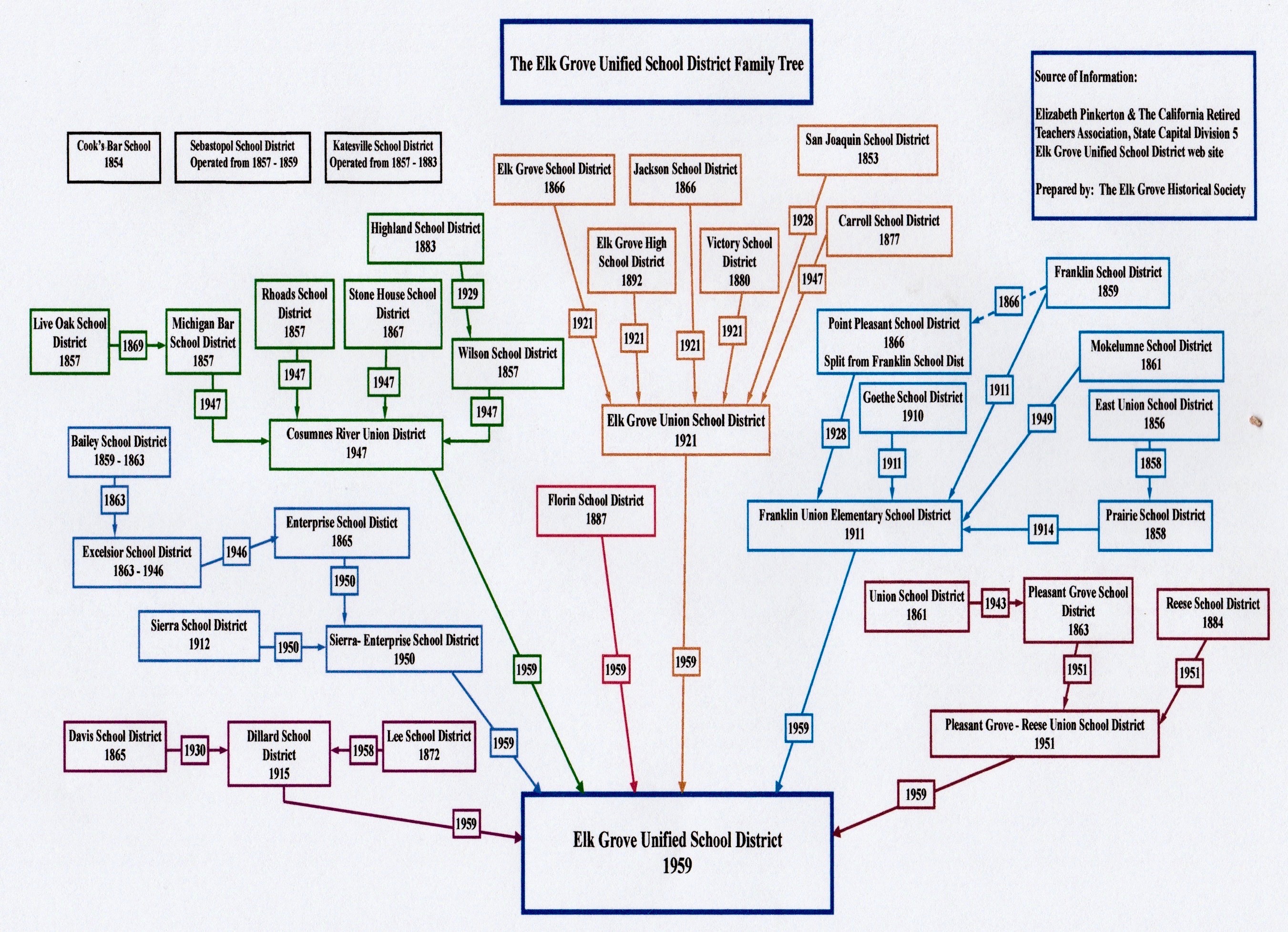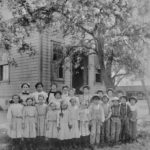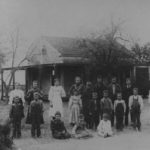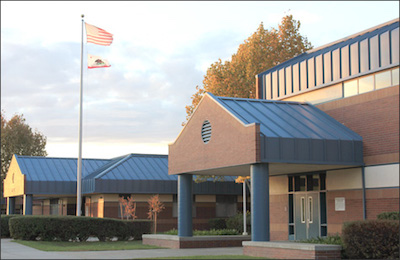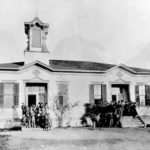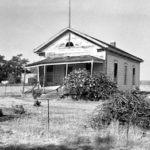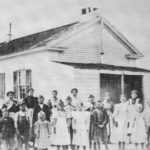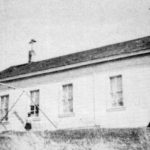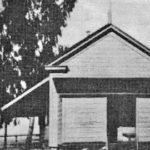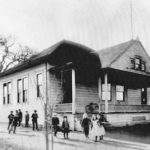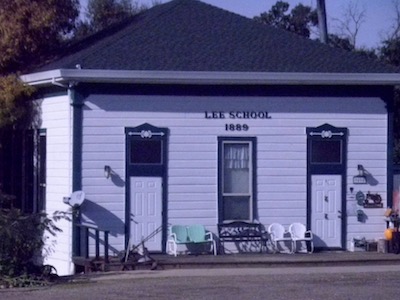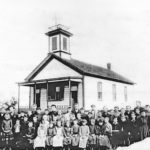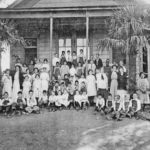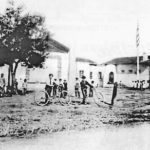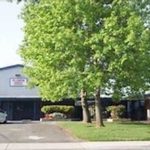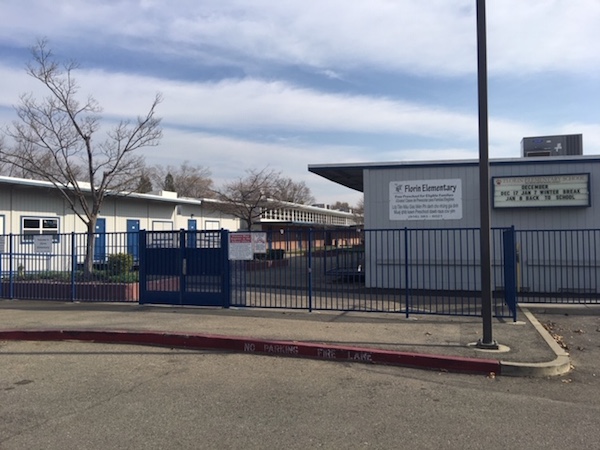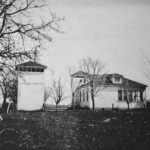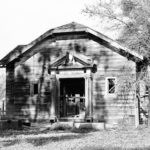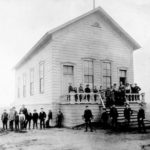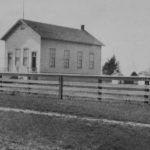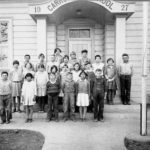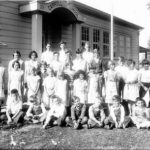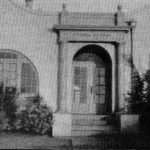Many years ago in the mid 1800’s many one room school house popped up in our area. The farmers and miners in those days realized the advantages of an education. Children needed to know how to read, write, add, subtract, learn to behave, and how to socialize. Those farmers and miners were willing to pool resources, donate land, build the schools, and pay taxes that were needed to maintain and operate the schools. Over time, several of those one-room schools burnt down and were either gone or rebuilt, sometimes a couple of times and some in other spots. Some were moved, some were annexed to other school districts like Galt, some schools combined with others, and some schools were simply abandoned. Below is a schematic (made by Barbara Claire) of the gradual unionization of the various districts that ultimately consolidated into the Elk Grove Unified School District in 1959.
Here is a list of those early schools with some bits of information, and perhaps a small photo to follow.
I. Elk Grove area: V. Sheldon area:
1853-The San Joaquin School 1859-Pleasant Grove School
1860-The Elk Grove School 1861-The Union School
1846-The Jackson School – Isabell Jackson School 1884-The Reese School
1881-The Victory School
II. Sloughhouse area: VI. Franklin area:
1849-Rhoads School 1856-The Prairie School
1854-The Katesville School 1859-Franklin School
1854-The Sebastopol School 1861-The Mokelumne School
1854-The Cook’s Bar School 1866-The Point Pleasant School
1857-The Live Oak School 1877-The Carroll School
1857-The Michigan Bar School 1910-The Goethe School
1860-The Wilson School
1867-The Stone House School
1883-Highland School
III. Wilton & South Cosumnes River area: VII. Sierra Enterprise area:
1865-The Davis School 1859-Excelsior School
1872-The Lee School 1856-The Enterprise School
1890-The Hicksville-Arno School 1912-The Sierra School
IV. Florin area:
1887-The Florin School
1913-The Florin School (Florin East School)
1923-The Florin School (Florin West School)
1952-The Florin School (present one on Kara drive)
I. ELK GROVE AREA
1853-San Joaquín School
This school has the distinction of having been the first school of record in Sacramento County. The year was 1853, and at that time there was not yet a public school in the Sacramento area. The San Joaquin was not the first school in our area, because the Rhoads School, built by Jared Sheldon has that award. But it was the first official public school in the Sacramento County area and we can take pride in that recognition.
Records tell us the San Joaquin operated two schools in 1854 and 1855. They were called # 1 and # 2, and some time later there were #3 and # 4. The Pleasant Grove School was known at one time as San Joaquin # 2 and later as #4. It is not entirely clear why there were four designations, but it is likely that the Elk Grove school may have been one of them. The first teacher at San Joaquin School was a Mr. Sullivan. He taught there for two years and was followed by none other than George Harvey Kerr who was one of the founders of Elk Grove. In 1863 there were 110 children attending San Joaquin #1 and San Joaquin #2, so there were plenty of children for two schools. Other teachers through the years were Bessie Etling, Lottie Stubbs, J. E. Kennedy, Eva Druge and E. A. Stickney. The San Joaquin School received its name from the township that covered all of Elk Grove and a good part of Florin as well, known as the San Joaquin Township. The school existed from 1853 until it merged with Elk Grove union district in 1928, joining Jackson, Victory and Elk Grove.
You may wonder about the San Joaquin name. If you do, don’t think countyas in the name of our neighbor to the south, San Joaquin County, and don’t think river as in the river south of our own Cosumnes River. But do think of the little cemetery at the intersection of today’s Highway 99 and Sheldon Road. This little piece of ground is still called the San Joaquin Cemetery, and it serves as a reminder of our geographical designation as San Joaquin Township in Sacramento County.
For the location, think about the spot just a few miles south of Elk Grove at what is the intersection of Grant Line and Highway 99. This is where the San Joaquin school stood – on the southeast corner of that intersection, which at the time of its existence was Upper Stockton Road, not the freeway that it is today. From early photographs, the architectural style of the school appears to be Greek Revival, the most common structural design of country schools in the gold country of California. The Greek Revival design was brought west by those who came to mine gold. It was the miners’ vision of what a school should look like in their new California land. You can see how similar San Joaquin School was to the Rhoads School that sits in Elk Grove Park even though Rhoads was built 20 years after San Joaquin. The big difference in the two is the striking bell tower that graced the San Joaquin. That bell may be somewhere in our midst, but I can’t recall where, but Bob Lent, who lives across the road from where the school was may have the flagpole tucked away in a barn on the Lent Ranch.
1860-Elk Grove School
1860-1880
Do you know that there are four buildings in the Elk Grove area that have had the name of Elk Grove School? Sometimes the designation of grammar school was used and other times it was called an elementary school. Only a few among us know of the first Elk Grove School. It stood out there at what is now the intersection of Elk Grove Boulevard and Highway 99. This was the third school in San Joaquin Township, dating back to 1860. It may have been called San Joaquin # 3 until 1866 when we know for sure that it was called Elk Grove School. A second Elk Grove School was constructed, probably larger and more modern, but we only know that this occurred in the 1880s.
The Elk Grove School was located one-half mile north of the settlement known as Buckner, and referred to also as the 14-Mile House. This was the second site of Elk Grove at Upper Stockton Road and what later became known as Main Street/Elk Grove Boulevard. The school was on the southeast corner of a piece of property that fronted Upper Stockton Road. The school faced easterly and was built perpendicular to the roadway. One of the prior owners of the land opposite Elk Grove School was the notable figure in Elk Grove education, Alfred Coffman who was later instrumental in the formation of Elk Grove Joint Union High School in 1893. Mr. Coffman apparently resided opposite the school from 1877 to 1897 and also served as a trustee of the Elk Grove School District. During this period the second Elk Grove School was raised where it still stands on West Stockton Boulevard. Given Mr. Coffman’s enthusiasm for the creation of a high school district it seems logical to assume he probably had something to do with the construction of this school as well.
The first Elk Grove school building was taken over by the Foulks family and hauled to Foulks Ranch. It is likely that it was sold in the 1920s to help pay for the new Elk Grove Grammar School. That old school sits there today in the middle of the Laguna Creek development, but still on the Foulks property. For many years the old school building was used as a club house for the Foulks family with many community gatherings held there. The Elk Grove Historical Society held its Christmas party there more than 20 years ago. That’s probably the last time it was used for a community function, but the building is still there, used for storage and waiting to be brought back to public life again.
1880-1921
The second school called Elk Grove still stands north of Walmart along old Upper Stockton Road, now West Stockton Boulevard (Highway 99 Frontage), a stone’s throw from the Elk Grove City Hall. This building, used continuously as a school until 1921, is still there, but it appears that progress will toss it aside one of these days unless a strong voice emerges to save it. The old school has been a residence for many years, but it served the Elk Grove community well until 1921 as a beacon of education.
Teachers from 1886 to 1915 included Mrs. Cora E. D. Gage, Katie H. Wilber, Mabel M. Leimbach, Nina L. Garwood, Mrs. Jennie Clyborn, Agnes M. Smith, Ada M. Gage, Edna Briggs, Carrie Webb, Bessie Etling, Ervin Schuler, Pauline Kramer, Greta Mosher, (Widow?) Irene Baker. Salary during this time ranged from $60.00 to $70.00.
Although you would not know it, the Elk Grove School had a bell tower and bell according to Joseph Brugler as described in his short story. Ernst Korf purchased the old school building in 1947. It was already a residence by then; he rebuilt the place somewhat and applied new siding, probably preserving the original wood underneath. In 1970 the Elk Grove School was purchased from the Korf family by a Mrs. Nestle. The Elk Grove school building is a proud reminder that this is where the town of Elk Grove grew up so long ago. We need to make an effort to preserve this building so that future generations will know about early day Elk Grove.
1921-1995
Many folks will be able to identify the third school with an Elk Grove name – the brick building on Elk Grove Boulevard. This is the building that had the sign that said Elk Grove Grammar School. The brick building was the elementary school for Elk Grove from 1921 to 1995. For 1922-23, apparently at the new Elk Grove Union Grammar School, six teachers are listed: G. A. Forrester, Alma Collis, Julia Knox, Anna Kirchgater, Virginia Parker and Dorothy Buckner at pay rates ranging from $120.00 to 155.00 for 12.
An addition was built in the back of the school in the 1950s to handle the growing baby boom population of the post World War II days. This is also when the Elk Grove district built the Anna Kirchgater School in the northern part of its district where there were many new families in the Power Inn Road area. This building was home to the Elk Grove Unified School District offices from 1967 to 1994. For several years, classes from Joseph Kerr Jr. High, across the street, were also held there. It is hard to envision school children crossing that busy street each period of the day, but that is what they did when the junior high opened in 1964.
The beautiful brick building houses the Elk Grove Community Services District today. As you can still see, the grammar school was a well constructed building with a distinctive entrance bordered with white pillars. As you entered the school through the great double doors, a counter to the right housed the school secretary. The principal’s office was right behind it. The large room that is now used for the Community Services Board meetings and other community gatherings was the auditorium and music room. Classrooms lined both ends of the building, but they were all converted to office space in the late 1960s as the students moved into the newer classrooms.
Elk Grove Grammar School was its own school district until 1959 even though it included the student populations of what had been three other independent little school districts (San Joaquin, Victory, and Jackson). The district was governed by its own trustees who handled all the business of the school. The principal and teachers took care of the instruction. Raymond Case was the Elk Grove principal in the late 1950s when he encouraged the Mothers’ Club to start Western Festival. Mr. Case arranged for the planting of the rhododendrons, azaleas and camellias that we still enjoy there today.
1995-Present
The fourth school with the Elk Grove name is the present one on the north east part of town. The new campus of Elk Grove Elementary opened in 1995. The school is now home to nearly 1,000 students from kindergarten through grade six.
1866-Jackson School
The Jackson school was built on what is now Calvine Road, about a mile east of Stockton Road, today’s Highway 99. The building still stands, just west of Short Road, where it has been a residence for many years. The Jackson School, named for the early pioneers of that region, joined with Elk Grove and Victory schools in 1921 when the new Elk Grove Grammar School was built. The Jacksons were early pioneers of the area who were friends and relatives of the Kennedy family. Today’s Isabelle Jackson School is also connected to the families mentioned here. Mrs. Jackson was a Leimbach and her husband was a direct descendant of Henry C. Jackson for whom the original school was named. The Jacksons lived near Sheldon Road and Upper Stockton Road, and they were all involved with the Ebenezer Baptist Church that also stood at that location. The cemetery is all that is left of the little settlement that once was there.
Isabelle Jackson School
Isabelle Jackson had taught at Florin School for many years. She was a teacher, then the principal, and later, she was the superintendent of the Florin District. In 1957 the Florin District built a new school on Orange Avenue to house the increasing numbers of new students that were moving into the Stockton Road area. The trustees named the new school the Isabelle Jackson Elementary School in honor of this long time educator. The original Isabelle Jackson School is now William Daylor Continuation High School.
A new Isabelle Jackson School was built by the Elk Grove Unified School District in 1985. The Florin district became part of the Elk Grove Unified School District in 1959, and immediately new schools were built. First there was the new elementary school named Samuel Kennedy in 1963, a new junior high school, James Rutter in 1965, and another elementary school, David Reese in 1966. There were three new Florin schools in a period of three years!
1881-Victory School
Victory School was built in 1881. The architecture was quite different from that of other schools, and the name was different too. But the story of how the school came to be is even more unique. You could say that Victory was truly a school of parental choice because that is how it came to be. What happened is that the people of Elk Grove took things into their own hands and created a school district they could call their own. They were tired of the long distances their children had to walk all the way out to the school on Stockton Road (Highway 99 today). The railroad had come through the area, but it had missed the town of Elk Grove, and little by little, the town moved closer to the railroad tracks. There was no school in the new Elk Grove for the children, so the townsfolk petitioned to divide the Elk Grove district and create their own school district. The end result was that the citizens of new Elk Grove formed their own school district and built their own school. Excited about their victory, they called their new district Victory, and the new school was christened Victory School. All this happened in 1881.
Victory School was east of downtown Elk Grove just past Locust Street, a block off Main Street. That is why we call School Street by that name – it is where Victory School was built. Alex Estridge was the building contractor, and Miss Darling who had taught at the Elk Grove Grammar School was hired as the first teacher. A windmill was the source of power for the water in the school. Every school day, at 8:30 a.m. and at 12:40 p.m., the bell in the tower was rung. It was very special for a student to be assigned to pull the rope to ring the bell.
Initially a one room schoolhouse, a second room was added to Victory School, and in 1919 a smaller building was built to accommodate the seventh and eighth grades. The school had more than a hundred pupils at the time it closed to unify with the Elk Grove and Jackson districts in 1921. Unfortunately, Victory School is not available for us to view today. The school burned to the ground shortly after it closed in 1921. Eighty years later, in the winter of 2001, a large valley oak fell to the ground on School Street. It had stood in the front yard of the Victory School. Something that was unknown to most people was that initials of the long gone pupils of Victory School were carved into the trunk of that tree. Years ago, Judge Godfrey Mix, who lived next door and who had gone to school at Victory, showed the initials to me. They were high in the tree at that time, and I regret that I did not take a picture of them. The Judge also showed me the two big branches that were designated for swinging – one for the girls and the other for the boys.
II. SLOUGHHOUSE AREA
1849-Rhoads School
Even though the Rhoads School is not contained in Heritage Park it is still part of the Elk Grove Historical Society’s buildings and is located in the center of the Elk Grove Park. Here is the history…
In 1840, Jared Sheldon and William Daylor both worked at Sutter’s Fort – Sheldon as a carpenter, and Daylor tending herds. While seeking strays one evening, Daylor viewed the Cosumnes River Valley and reported back to Sheldon of its desirability and potential for settlement. Sheldon applied to the Mexican government for a land grant of over 18,000 acres and, in partnership with Daylor, established the Omuchumnes grant.
Both Daylor and Sheldon married daughters of Thomas and Elizabeth Rhoads. The Rhoads family had arrived in California in October of 1846 and their son, John Rhoads, became a member of therelief parties. He is credited with carrying Naomi Pike out of the mountains to safety on his back. While the reason for naming the school district “Rhoads” is historically uncertain, it seems most likely that it was to commemorate this heroic deed.
The first Rhoads School was built in the 1850’s by pioneer Jared Dixon Sheldon. It was close to the Cosumnes River, which was subject to flooding. Children became sick from mosquitoes bites, which we now assume was malaria, so the school closed in 1872.
In 1872 the second Rhoads School was built on Sloughhouse Road as a community effort. Its financing was by public subscriptions, cakes and pickle sales, and a benefit ball with tickets at $3.50 each. Total expenditures were $1,312.60, which included the schoolhouse, outhouse, insurance and some furnishings that were simple; desks for students, a desk and chair for the teacher, a stove, clock, broom, bucket, and dipper.
Both schools were named after John P. Rhoads, who arrived in California from Illinois in 1846.
The Rhoads wagon train traveled part of the way west with the Donner Party, though the Donners were about three weeks behind them as the Rhoads passed through Salt Lake City.
History has revealed the tragedy that met the Donner Party as they attempted to cross the mountains in what proved to be and unusual ferocious winter.
John P. Rhoads was one of seven men who volunteered for a rescue party to carry supplies to the Donner Party and bring survivors to safety. In all, he made three rescue missions.
The school opened in May 1872 with Agnes S. Jaycoax as teacher. There were 21 students enrolled, with an average daily attendance of 15. The school taught 1st through 10th grade. Ages 6 through 17 were taught and the school started out as non-graded, but when then was rated as “first grade” meaning that the teacher passed the county examination with a very high score.
All teachers were required to be at least 18 years of age and to hold a valid teaching certificate granted by the County Board of Examiners. Teacher’s salaries at Rhoads from 1872 to 1906 ranged from $55.00 to &84.80 a month, including room and board. The teacher would board with different families throughout the year. Some families were gracious and some were reluctant. Most times the teacher would walk 1-3 miles to and from school, rain or shine, carrying lunch, books and school papers.
Drinking water was carried by bucket from the well across the road at the Taylor (later the Murphy) Ranch. The bucket, with a dipper sat on a wooden bench in the cloakroom. The children drank from the dipper, and returned it to the bucket. The Taylors and the Murphy’s also allowed watering trough privileges for the horses of the children that rode to school.
Besides carrying water, students’ chores including hauling wood. The stove stood in the middle of the classroom, and was the schools only source of heat. There was no artificial light, and on very dark days, kerosene lanterns were used to add light or class was dismissed early.
The schoolyard was large, but not improved and very little play equipment and only one out house. After the first year, a second out house was built. The boy’s facility was northeast of the school – the girls was to the southwest.
Graduation exercises were usually school performances and entertainments. Usually, no more than 5 or 6 students graduated, some years none or only one. Students traveled to Sacramento to take graduation examinations to allow them to go on to high school. (Note: Elk Grove HS was built in 1893).
The 1866-1867 school year was the last time that Rhoads School District appeared in either state or county school records until 1872 when classes resumed in the newly constructed school building. It is also uncertain why the original Rhoads School closed down, but it is believed that too many children were becoming ill by exposure to “bad night air”. That is, they were contracting malaria, possible due to the school’s location in the bottomlands of the river. It was also a fact that many families were moving away. The original building burned to the ground, possibly while it was closed due to the malaria outbreak, but the timing was unclear.
In 1946 the Rhoads, Michigan Bar, Stonehouse, and Wilson Districts combined into the Cosumnes River Union School District. In 1959 the Cosumnes River Union School District became part of the Elk Grove Unified School District.
In 1976, the Bicentennial Year, the Rhoads School was moved from its home on Sloughhouse Road to the Elk Grove Park. The school was given by the Murphy family to the Sacramento County Parks Department. Members of the community contributed hundreds of hours restoring the deteriorating building and returning it to its appearance around the end of the century.
With the school in Elk Grove Park, the newly formed Elk Grove Historical Society assumed responsibility of administering it for the community.
Today the Rhoads School serves two purposes. It is a Living History Program for school classes in the Sacramento County area, and it is also a museum that is open to the public several days a year, when there are special events at the Elk Grove Park. We have expanded our open hours from 1:00 pm to 4:00 pm on the first Saturday of each month when the Elk Grove Stage Stop Museum is also open.
The Rhoads School Living History Program introduces children of today to the education life of children of the 1890’s. Third and fourth grade classes spend a day at the school, learning what it was like to be a student in a one-room schoolhouse so long ago. They come to school wearing clothing typical of what would be worn by farming children of that time.
Their subjects are the usual reading, writing, arithmetic, spelling, and also elocution and penmanship. They played the recess games that were played so many years ago. – Marbles, jacks, hoops, jump rope, and stilts.
Presently, we schedule 80 classes a school year that are taught by 6 docents. Contact us at rhoadsschool.com for information.
For many photos of the Rhoads School, go to the menu on the right and look in the “Photo Gallery.”
1854-Katesville School
We know that Katie V. Beale (pronounced as Ball) married Jonathan Ogden Sherwood and that they had four children. They lived three miles south of the Arkansas Creek and three miles east and west from the foot of Big Ravine, between Cook’s Bar and the Arkansas District. The mining camp and school were named for Katie in 1854 although there had been mining there as early as 1852. Katie founded the school, her husband built it, and Katie was also the schoolteacher there. In addition to the school, there were a hotel, boarding house, store, blacksmith shop, and several saloons and dwelling houses. There were 33 people there in 1866, and in 1868-1870 the operating expenses of the district were $254. The property was valued at $370. The clerk of the Board was J. O. Sherwood of Michigan Bar. By 1883 the mining was gone, Katesville ceased to exist, and the school was closed. The miners moved on to other more lucrative streams.
1854-Sebastopol School
Sebastopol, established in 1854 in Cosumnes Township, was given its prominent Crimean War name by the gold miners who first set up camp there.[i]They must have had access to worldwide news even though they were so isolated. The school the miners created was in the mining camp, but it lasted only as long as the camp stayed open. In its bustling, lively days Sebastopol had a hotel, general merchandise store, dry goods store, saloon, bowling alley, cigar store, butcher shop, blacksmith shop, shoe store, miners’ cabins, and dwelling places. They might have all been tents, but they were listed as places of business. And business they had, for at the heyday of Sebastopol, 400 ounces of gold dust exchanged hands each week. We know that Chinese people worked in Sebastopol in its later years. As far as can be known, the school was open only until 1859, and by 1880 there was nothing left of the settlement of 200 people.[
1854-Cook’s Bar School
Gold was found in 1849 at this Cosumnes River bar, nearly two miles past Michigan Bar, by a miner named Dennis Cook. The place was near where Jared Dixon Sheldon built his dam that flooded the claims of miners. From 1854 to 1870 there was a large hotel called the Cook’s Bar Hotel, and there were a number of stores and saloons for the 500 inhabitants. By 1860 all the people had left, moving on to better diggings.
1857-Live Oak School
This school district was first known as Cosumnes Township # 1 from 1857 to 1863, and after that time as the Live Oak district. In 1869 Live Oak joined Michigan Bar district. In 1865-66 there were 60 children enrolled in the school. The average daily attendance, however, was 38.4, so it looks like regular school attendance was not a high priority. An interesting note is that in at least one year, 1868-69, the school was open for eleven months. The teacher’s salary was $75 per month, and the school expenses were listed as being $1,325 for the year.
The Hamilton line of stages ran through Live Oak as they traveled from Sacramento to Michigan Bar. Wells Fargo had an office in Live Oak from 1858 to 1861, and we know that there were also livery stable, blacksmith shop, butcher shop, two hotels and four saloons. Much gold was taken from the river at this point for there are stories of as much as $3,000 worth of gold dust taken each week. Like Sebastopol, there were also Chinese miners in Live Oak, but the settlement was no longer in existence by 1861.
1857- Michigan Bar School
This district was first called Cosumnes Township # 2, but in 1859 it was renamed Michigan Bar. There were 2,000 people living at Michigan Bar in the 1850s and 1860s. This is how Michigan Bar got its start. The town received its name in 1849 when two gentlemen from Michigan, Tommy Prothro and the other unknown, found a rich bar of gravel-bearing gold at the place where the Cosumnes River made a bend in its journey to the valley. The spot was west of the place where Sacramento County joins its sister counties, El Dorado and Amador.
Samuel Putnam built a toll bridge across the River at Michigan Bar in 1863. It is said, and likely true, that Putnam carried away more gold than any miner who spent his days working the muddy waters. Michigan Bar had a post office, blacksmith shop, hotel, and two schools, the Michigan Bar School and the Buckeye School. Michigan Bar had another claim to fame in addition to gold and a bridge. The unique clay of the area gave birth to quite a good business in clay products including pottery, sewer pipe and stoneware.
The school was originally on the north side of Jackson Road, but it was moved to the south side because there were more families on that side of the road. This school continued into the 20th century and was not closed until 1947. In 1912, there were 18 students and the next year, there were 32, so you can see how people were moving about. By 1970 there was only one family living at Michigan Bar. But then came Rancho Murieta, and the hills began to change again. As recently as the 1970s, the remnant of the flagpole of Michigan Bar School could be seen, standing alone on the hill across Jackson Road from Michigan Bar Road
1860-Wilson School
The original Wilson school and store were on a bluff that overlooked the Cosumnes River, about a half mile west of today’s Dillard Road, between Meiss Road and Jackson Highway. Wilson had bought part of the Hartnell Grant, and he ran the store that was called Wilson’s Exchange. There was a ferry there and also a bridge that was washed away by the 1865 flood. Over the years most of the families moved away from Wilson’s, but there was a need for a school on the other side of the Cosumnes River. The creative parents and community members picked up the school one spring day when the water was high, put it on a barge, and floated it to the a spot high on a bluff, not far from the present Cosumnes River School. No wonder members of Elk Grove’s Board of Education are so creative in solving school facility problems – look at the traditions they are following!
1867-Stone House School
A bit west of today’s Rancho Murieta was Stone House School. It is pretty clear that there were two schools at Stone House over the years. The second school was an active school until the late 1940s. Why was it named Stone House? Old timers say there were many Chinese who lived in the area. They came there after they finished building the railroad that linked the West to the rest of the nation. Mining was still somewhat profitable, they also engaged in searching for what was left of the gold. People generally left them alone. The Chinese perfected the craft of stone construction, and there were some houses made of stone. Stone House Road still exists and is a reminder of those long gone days.
Melinda Peak, consulting archeologist with Ann Peak Associates, Inc. provided the following information about a Stone House near Stone House School. “In 1979 archeological excavations were conducted at the S. E. Connor cabin behind Rancho Murieta about 1 mile from Stone House School. The S. E. Connor cabin dated to the 1860s and utilized Irish construction techniques including stone floor, walls, chimney and unique stone shingles secured with wooden pegs.”
1883-Highland School
Highland School was located on Middle Jackson Road, now Kiefer Boulevard, a mile west of Grant Line Road. The district operated from 1883 to 1909 and then closed intermittently to 1929. In 1930 it was attached to the Wilson District. After the school burned, the county took over the property.
III. WILTON & SOUTH OF COSUMNES RIVER AREA
1865-Davis School
The only reminder we have today of the Davis School is the road by that name, that intersects with the present Dillard Road and goes south to Walmort Road. The school was probably at the intersection of Davis and Walmort Roads. Davis School was built in 1865, and the school enrolled 20 children that first year. It is likely that the school was on the property of his family – thus the name. We also know that D. L. Davis, who listed Hicksville as his address, was the clerk in 1867.[i]We do not know why the school was only open for five months, or even which five months those were. In 1868 the school was only open for three months, and again we do not know if this was due to lack of enrollment, lack of funds to operate the school, or there not being a teacher available. The school struggled on though, with Alice Robinson of Elk Grove being the teacher there in 1915. Finally, though, the school suspended from 1922 to 1929, and then lapsed in 1931, attaching itself to the Dillard district.
1872-Lee School
The Lee School was between Wilton Road and Sloughhouse Road, right off Baden (now Dillard) Road and near Tavernor.[i]Today we have two short roads there – Lee School Road and Lee School Cross Road. The official enrollment for Lee School was only 7.6 students in 1872. If you wonder how there could have been a .6 student, keep in mind that average daily attendance is calculated for the entire year, so we can assume that there were more students enrolled – they just did not attend regularly. Lee School joined with Dillard School in 1959 when they became part of the Elk Grove Unified School District.
An article in the Elk Grove Citizen nearly 30 years ago told about the transformation of the old Lee School into a modern residence by the Horning family. The project was cited as a Bicentennial project that gave the old Lee School a new lease on life. The article went on to comment about Silas Stewart who apparently built the school back in 1882. Neighbors had said that anything he built was sure to last – and it did!
1890-Hicksville-Arno School
The names of Arno and Hicksville are both used to describe the settlement south of the Cosumnes River on today’s Highway 99. Arno Road is there today, and we also have the Hicksville Cemetery. The place was originally called Hicksville, and it is the oldest settlement in this area, even predating Sloughhouse. Billy Hicks, the person who founded the place, came here in 1843 and acquired the property. It is quite apparent that the Countess Valensin did not favor the name of Hicksville to describe the place where she lived, so when the railroad came through in 1868, she named the station Arno. It is said that this was a reminder for her of the Arno River in Italy. When the Hicksville School burned down, it was rebuilt and named Arno in about 1890.The Arno School closed in 1954 when it joined Colony and Herald districts. It exists now in the first two letters of the name of the new school district, ARCOHE, which is centered in Herald.
IV. FLORIN AREA
1887-Florin School
The town of Florin grew up around the railroad tracks after the Central Pacific tracks were put in, and the first school was built in 1887 and was located on McComber Lane, east of the railroad tracks. We know that Fannie Osborn was the teacher in 1898, and then an increase in students brought Mr. Osborn to the school as principal. By 1901 there were 71 children enrolled at Florin School. Mrs. Osborn later became a member of the Sacramento County Board of Education.
1913-Florin School (East)
Fire destroyed the original Florin School in 1913, and a new school was built on Florin Road at McComber Lane. This is the building that is still there, but it has not been an elementary school for a long time. Elk Grove’s Adult Education program has used the charming building for many years, particularly for classes for adults who are learning English. The school has come full circle from having housed children who spoke Japanese to adults who speak the many languages of families in the Elk Grove-Florin area.
Many local residents went to school at Florin, but one of the most famous was a lad called Hiram Johnson who attended Florin in 1916. If the name sounds familiar it is because Hiram Johnson served as governor of California, and yes, Hiram Johnson High School in Sacramento is named for this Florin student.
1923-Florin School (West)
The growing population of Japanese farmers and their families resulted in a continual increase in student enrollment at Florin School. From 127 students in 1922, the enrollment increased to 155 in 1924.
With such an increase in population, the voters of Florin approved a school bond of $1,700 to build a new school. This was a fine brick building on Florin Road and Power Inn Road, west of the existing school. For whatever reasons, Florin then took the unusual action of segregating its students, being one of only four schools in California that separated its students by race. This brick school was closed when the present Florin School was built in 1951. Years later, the brick building became the victim of vandalism and neglect.
1951-Florin School (Present)
In 1951 the Florin Elementary School was built on Kara Drive and all grades were joined together again in one school
V. SHELDON AREA
1859- Pleasant Grove School
Pleasant Grove School dates to 1859 when it was created as the second school in San Joaquin Township, the first being at the intersection of Grant Line Road and what is now Highway 99. It was first called San Joaquin # 2, and at other times, San Joaquin # 4 and Mt. Pleasant, but it was eventually given the name of Pleasant Grove in about 1863. The school has had 139 years of history with that name. The name of Pleasant Grove reflects the country atmosphere of the area. It brings forth the image of education as being a worthy endeavor in an environment that is agreeable and filled with pleasure. Located near the town of Sheldon, the Pleasant Grove School and its adjoining cemetery are treasures of days long gone.
In 1951 the Reese school on Bradshaw Road was closed and the district combined with Pleasant Grove. For a period of time, after the closing of the Reese School on Bradshaw Road until the opening of David Reese Elementary in 1966, Pleasant Grove School was known as Pleasant Grove-Reese School, and PGR for short.
1861-Union School
The Union School was located between Grant Line Road and Deer Creek. A school existed here from 1854 to 1861, but it was known as Lindsay according to the records of Sacramento County Schools. Not much is known about this earlier school, but we have information on the Union School that was built in 1861 and served the community until 1943 when it burnt down and was never rebuilt. The students then attended nearby Pleasant Grove School. The school was located between two large dairy ranches, the Bryte ranch and the Orelli Ranch. The name of Union for the school in 1861 is not surprising when we think of what was happening in the nation at that time. Union School was one of our connections to the Civil War and so was the stage stop called Union House – an indication of the feelings of our mid 1800 residents to support the continued union of the states. Like other early day schools, Union School had its cemetery near by. (AKA – Union School Cemetery and Center Tomb Cemetery)
1884-Reese School
It is somewhat surprising that within 20 years another school was needed in the vicinity of Sheldon and Bradshaw Road. The Reese School was built in 1884 on land donated by the Reese family on the west side of Bradshaw Road about a half mile south of where the Traction Line later crossed Bradshaw, between Calvine and Gerber. The family had been prominent in the development of Florin, particularly with the fruit industry. John and Elizabeth Reese had five children: Catharine, Thomas, John, Elizabeth, and David. John Reese was a shoemaker who brought his family from Wales to New Orleans and from there to Salt Lake City, Utah. Their son David Reese was married to Mira Kilgore; he was one of the founders of the Florin Fruit Growers Association and was also the sheriff of Sacramento County in 1902. A new school on Lindale Drive in Florin was given the name of David Reese in 1966.
A new chapter for the Reese School opened in the summer of 2002 as Russell Newland began a search for a new home for the school. The school was moved in 1952 from Bradshaw Road to the ranch owned now by Mr. Newland off Grant Line Road. In 2007 the school was moved to the Elk Grove Historical Society Heritage Park and funds are being raised for its restoration.
VI. FRANKLIN AREA
1856-Prairie School
Prairie School was located on Lower Stockton Road (Franklin Road), and was the little school that served the community that grew up around the stage stop called Union House. The school was called East Union for its first two years, but in 1858 it was re-named Prairie when the school of that name in Folsom was closed. The residents petitioned for and were granted a school in the area of Eagle point, east of what became West Union. This reference is not clear, but this is what is stated in a history of public schools in Sacramento County.[i] The district was known by various names including Sutter, Franklin East Union, Franklin #2 East Union, and finally, Prairie. John Reith, who lived at Union House, served on the Board of Trustees of Prairie School for 30 years. You can read more about him in Chapter 3, Families of the Pioneers.
It appears that Prairie School was the pioneer school in this part of Sacramento County within the boundaries of what is now the Elk Grove Unified School District. The first was San Joaquin in 1853, so East Union-Prairie could have been the second school. We know that Prairie School served 35 students in 1888, which was quite a sizable number of students of all ages and grades. By 1914 there were only 14 students enrolled, and the next year the Prairie district merged with Franklin. The name of Prairie is a reminder of the meadowlands and the vast acres of wildflowers that stretched all the way to the Sacramento River. Perhaps it made the first settlers remember the wide prairies they crossed to get to California.
Prairie School was originally located on the Charles Mack property, north of Mack Road and east of Franklin Blvd., facing in a westerly direction. After a couple of years of use, it was decided that Prairie School was too close to the Pacific District, so the decision was made to move the school to the south. Henry Watson was hired to move the school building, and he accomplished the job with a team of six oxen. Prairie School was taken one and a half miles down Franklin Road to the Charles Hull ranch, just north of the Union House stage stop. In order to face the school in an easterly direction and also have it face the Franklin Road, Mr. Watson had to make a wide circle in the meadow with his oxen to bring the school around to that position.
The school’s construction was of wood and there was a small covered porch at the center front entrance. As you entered the building, there were anterooms on each side which formed a kind of hallway. At the other end of this large room was a built up stage, and the teacher’s roll top desk sat in front of it. The building was a little longer than the average school at that time. The eight grades of students enjoyed using the stage for their performances. This school was one of the few that didn’t have a bell tower. Henry Ehrhardt, who was a student at Prairie, stated that the teacher used a hand bell to call the 25-30 students to class.
The porch was only about two steps high and had steps which came off the front. It also had steps leading off each side that went around to the outside privies. The heating was supplied by the typical pot bellied stove that burned wood.
Mr. Ehrhardt also recalled that there was no play yard, and the students played games on the Franklin Road. The boys played tops, which they would throw at the lowest plank of the school building. When the teacher, Mr. Albert Leimbach, would catch them he would take the tops away, but returned them after a week. He also said they played tom ball, which was similar to our baseball of today, except you could wait for a good ball before striking without any limits of balls and strikes. Whenever a horse and wagon came by, the students had to get out of the way, but since they were not going 60 miles an hour, they had plenty of time to get off the road.
The first teacher that we have records on for Prairie School was Albert Leimbach in 1880. This was Albert Watson’s first grade teacher. Next were a Mr. Kane and then a Mr. Cromwell. It was said that Mr. Cromwell would go over to the Union House Saloon and have a beer for lunch. Other teachers as remembered by Mr. Watson were Miss Alice Belmer, Miss Ora Hunt, and Miss Alice Magann, who also taught in the Victory School at Elk Grove (1891-92). The next records show that Mr. Ed Jones taught from 1902-1909, followed by Miss Lesser, Miss Olive Martinelia, Miss Ward, Miss May Worthington, and Miss Lina Merwin. The school closed when it joined the Franklin School District in 1914.
When the school building was no longer needed for the purpose it was built, the community surrounding Union House used it for meetings and as an election precinct. As it became dustier on the inside and more weather-beaten on the outside, it was finally abandoned altogether and torn down. The furniture was sold and Mr. Watson purchased some. Dwight Stephenson also purchased some, and it was believed that in 1965 he still had the teacher’s oak desk and some chairs.
Some of the trustees of the Prairie School District in addition to John Reith were Henry Watson, Arthur Webb, Henry Nicolaus, Paul Sims, G. Brainard, and Tom Stephenson. Several other community leaders in those early days were Myron Smith, Charles Mack, Charles Hull, and Joseph Sims. [ii]
Because this was a former school district, though abandoned, the Elk Grove School Names Committee of 1965 recommended that Prairie be considered as a name for an elementary school near the area served by the original Prairie School. This was done in 1981.
1859-Franklin School
The Franklin district was established only three years after Andrew George founded the town of Georgetown, later known as Franklin. The Franklin Educational Association was incorporated, and documents filed with the Secretary of State on July 9, 1874. The intent was to establish a “first class academy” in the town of Franklin. The community members who took on the responsibility of serving as the directors were as follows: James M. Stephenson, William Johnston, Henry Ehrhardt, Grace F. Freeman, William H. Frye, Amos Adams, and P. R. Beckley.[i]It took them a couple of years, but in 1876, the Franklin folks built a new school, the Franklin Academy. Their goal was to better meet the educational needs of the young people who lived in the growing little town and the farms around it. The Academy was designed to serve all grades because it was too difficult for students to go on to high school.
According to records, the school was built for the huge sum of $3,500, but it only operated for two years until 1878 because it was too expensive to operate. This is one of those times when one wishes that records were available to know who the key players were, how they convinced their neighbors to gamble on such a venture, and also so that we can know what went wrong in such a short time.[ii]Education did not end in Franklin though, for there was always a school available to serve the community.
Some of the early records do not give us a clear picture of Franklin’s schools, but we have a faded record of a meeting held at the Franklin School on October 4, 1950 that tells us quite a lot. It seems that the citizens of Franklin of a half century ago were very interested in preserving the story of their past. This is what they wrote:[iii]
“The Franklin School of 1887 stood and was in use up until 1910. The last few years it was propped by the north and south sides with heavy timbers so the prevailing wind would not blow it over.[We know about these gale-like Delta breezes, don’t we?] In 1910 a new Franklin school was built, and at this time the Franklin district was consolidated with the addition of the Prairie and Goethe school districts.[iv]
“It was still a one room school, however, with one teacher, Miss Rena Carlisle. Later the school board hired a man principal, Peter Kramer. The following year, Miss Carlisle became Mrs. Peter Kramer. These two teachers taught until the spring of 1950 when they retired from their labors.”[v]
“The first school bus was in 1910. It brought students from Prairie and Goethe school districts to the Franklin Union Grammar School. The bus was a four-wheeled box like affair covered with black oilcloth and drawn by a team of horses. The first bus driver was Pearl Wilson. The roads over which they drove were terrible. The old Franklin Road was the worst. Often that first winter, the horses were belly deep in mud. The great grandpas of many of the present students discussed this condition pro and con, their meeting place being the blacksmith shop. They decided to haul rocks and stones to make the road passable. This they did without charge or pay. With the fine community spirit, they felt well repaid having the satisfaction that the bus could get through.
“About 1930 the minister of the Point Pleasant Church started a movement to get the Point Pleasant district consolidated with Franklin. Although this led to his resignation, he accomplished his purpose. Now there were four schools operating as one. As the years went on, more rooms were added to the school and more teachers to the faculty. During the Depression, through the Works Progress Administration (WPA)[vi]funds and labor, a community hall was built on the school property. This has been used for community gatherings and the school gymnasium.”
Franklin folks have fond memories of the Kramers, an extremely creative teaching duo who were very innovative in their approach to children’s learning. The husband and wife team became part of the community, and their contributions as educators in a community are likely unequaled – either locally or in our state. The Kramers even took the Franklin students to the World’s Fair in San Francisco in 1939. What a field trip for two bus loads of children, most of whom had never been that far from home! The Kramers also started the first community Halloween party for children in 1925. This became a yearly event for Franklin youngsters. They also began the annual community Christmas party and the school/community closing party.
Cleanliness is next to Godliness– that’sa phrase that any former students of Mr. Kramer’s would recognize – even to this day. All the kids had to wash their hands after recess before they could return to class. Everybody had to have their own towel at school, which they took home on Friday and brought back clean every Monday morning. Cleanliness was one of the memories that Lucile Schmidt Albertini included in her account of Franklin education with the Kramers. She remembered having the best orchestra, playing various sports against Florin and Courtland, having green and gold sports uniforms, and sewing the Franklin emblem out of felt in sewing class.
Rena Carlisle Kramer was born in Florin, the child of the George Carlisles who were early settlers of the area. Although Peter Kramer was born in Kearney, Nebraska, he came to Florin when he was but a year old. The Kramers and Carlisles were neighbors in Florin. After Rena and Peter graduated from Florin Grammar School, they both took the County Teachers’ Examination and went to their new jobs. Peter was 21; Rena, a mere 18. Rena went to Roberts Island School in San Joaquin County, and Peter went to the Point Pleasant School.[vii]
The original Franklin School was not on the present site of Franklin Elementary School. The next time you drive by, notice the empty space between the cemetery and Franklin Boulevard. This is where the school buildings were. Dennis Buscher, Franklin’s wonderful historian, recalls hearing how Mrs. Kramer would have to take the children out of the old building when the wind blew because she feared that it would blow down. According to Mr. Buscher, the Kramers were instrumental in getting the hall-gymnasium built. Mr. Kramer got the WPA crews to tear down the old fruit shed barns by the railroad depot on Bilby Road. From that wood, the new building was constructed.
Deanna DeBoy was my student at Joseph Kerr in the 1970s. This is what Deanna wrote about the Kramers in her 7thgrade essay in which she took on the role of Mrs. Kramer.
I am Rena Kramer. For many years my husband Peter and I lived and worked in the little town of Franklin. I guess the reason we stayed in Franklin so long was because of the friendly attitude the town’s people had. They made us feel so welcome. Peter and I worked at Franklin Union School. It was a little school and not too many people heard of it. My husband was the principal of the school and we were both teachers. Peter taught the 7thand 8thgrades and I taught one and two. The subject I think I stressed the most was phonics. I also enjoyed reading Uncle Wiggly books to my little first and second graders. I guess you could say that we loved our work so much that we lived at the school. We had a little house right on the edge of the school grounds. On the side of the house was a little greenhouse that most of the children admired.
There was always something happening at the school. Every year for Halloween we had a carnival which included game playing, a wiener roast and a lot of other fun things. It made me so happy to see the smiling, happy faces of the children. A lot happened while we lived in Franklin. I had a son in the 1920s, and he decided to follow in our footsteps and become an educator. He then moved to Alaska. In 1949 my husband and I retired from our jobs. We lived in Sacramento together until the late 1960s when Peter passed away. I now live in the same house, and I often think about the wonderful times I had in that lively little town of Franklin.[viii]
Those of us who are amazed at the growth facing our Elk Grove schools in the year 2002 will see that history does repeat itself. The little Franklin school was bulging with students in 1950, more than a half a century ago. There were so many students at the school that they needed five teachers as well as a visiting music teacher. It took three buses to carry all the students to school each day. The enrollment was 162 and growing. The principal in the fall of 1950 was none other than our famous Toby Johnson, former Sacramento County Supervisor from the 5thDistrict. He is also the gentleman for whom the new Franklin middle school is named – Toby Johnson Middle School of 2002.
A legend in Franklin is the extent of parent involvement with their children’s education, and this is how it came about. According to what was told to me, it was a day in February of 1951 that two of the Franklin teachers happened to be sick on the same day. The school did not have enough teachers to continue instruction, so they had to send the children home early. Several mothers dropped by to talk about 4H activities, and they used the occasion of the children being gone to chat with the principal, Mr. Johnson, about ways to get more parents involved. One idea they came up with was to start a Mothers’ Club, and they decided to look into it.
With the help of Mrs. Herman Hein and the Elk Grove Mothers’ Club, a questionnaire was distributed to parents. An overwhelming number responded favorably, and thus was born the Franklin Parents’ Club. The first elected officers were as follows: Frances Sims, president; Lucille Watson, Vice President; Agnes Buscher, treasurer; Betty Kuhn, secretary; and Clara Wales, corresponding secretary. Dues were one dollar per family for the year.
The first community activity of the newly formed organization was a box social and raffle. For the young folks of today who may not know the simple, pleasant pleasures of a box social, this is how it worked. The ladies brought wonderful, delicious meals that they had cleverly packed in decorated boxes. The gentlemen bid on the boxes of their choice and the lucky bidder ate lunch with the lady who brought the box. This was a great way for young women and men to get to know each other. Many a long ago marriage resulted from a courtship that got its start at a box social. Naturally, hints were dropped as to the owners of the various boxes, and the more popular ones brought in lots of money before the bidding was over. For bachelor farmers, box socials were a no commitmentkind of way to meet the eligible ladies in an entertaining evening, and a community approved way to put their dollars to good use.
Franklin’s first fund raiser moved the school into the world of high technology of the 1950s. The principal channeled the funds toward a movie projector – a high priority and greatly desired by the students of more than 50 years ago.
1861-Mokelumne School
These records are not clear, but a school by that name did exist on Twin Cities Road and what we know of today as Franklin Road. That it existed as early as 1861 is somewhat amazing because there is not evidence of many families in that area. It is likely though that a school was needed close to home and that need might have influenced the parent/tax payers to start their own school. Records show that the school combined later with Point Pleasant and Franklin.
1866-Point Pleasant School
Point Pleasant was a district of its own until 1927 when it combined with Franklin. Like its sister schools of the 19thcentury, the Point Pleasant school was a one room frame structure, built to serve the children of the farming community and to provide them with a proper education. The building is still there in Point Pleasant, but only the most careful history hunter or Point Pleasant old-timer would be able to find it.
Milton Schmidt, Arlene Hein’s uncle, was one of first students to transfer to Franklin when Point Pleasant School closed in 1927. From that time on, Point Pleasant scholars attended Franklin School where for the next several decades they studied and learned under the dedicated care of the famed teachers, Peter and Rena Kramer. Mr. Kramer had been a teacher at Point Pleasant before he moved to Franklin.[i]
Point Pleasant joined the Franklin Union School District formally on August 3, 1927, the school building was sold to John Hein for $850. The transaction was described as follows: “A school building with out houses and appurtenances; it being situated in the Point Pleasant School district; it being the School Building at which school has been maintained by the former Point Pleasant School District.”[ii]There in those few words was the end of a school and a district. It is likely that others across south Sacramento County ended in similar fashion.
1877-Carroll School
The Carroll School on Lambert and Bruceville roads served the long gone community of Bruceville. A family named Carroll owned land that adjoined Eschinger Road in the 1850s; they may have donated land for the school. The school that was built in 1877 was too small by the 1920s and a new school was built to replace it, spearheaded by Barbara Comstock Morse. The school burnt down and the Carroll district annexed in Elk Grove in 1946, but when the Elk Grove district was unified in 1959, the Carroll School students were assigned to Franklin.
Dave Morse was one who attended Carroll School, and so did the rest of the Morse family. Their mother, who served on the Board of Trustees for Carroll School District, now has a school named for her. We will have two other reminders of Carroll School, both in East Franklin. One will be the Helen Castello School, named for the long time Elk Grove teacher who once taught at Carroll School. The other will be Carroll School itself, a response to the commitment made by the Elk Grove Unified School District Board of Education to bring back the names of the long ago country schools.
1910-Goethe School
According to records of Sacramento County, the Goethe School District, in south Sacramento County, was created in 1910, closed in 1922 and became part of the Franklin District. However, it is quite clear that there never was a Goethe School; it was part of a developer’s plan for H. J. Goethe Colonies. Property was all mapped out in parcels, ready to fill with folks who wanted country living way back then. When Mr. Geothe’s dream crashed to the ground, so too did the plans for Goethe School. So if you find yourself looking for Goethe School, don’t waste your time as the school was never built.[i]
[i]Letter from Gottlieb G. Kammerer, March 10, 1992
VII. SIERRA ENTERPRISE AREA
1859-Excelsior School
Excelsior School was the first school in this part of Sacramento County in 1859. Today’s Excelsior Road puts you close to where Excelsior School once stood as the school was located a mile south of the intersection of Excelsior Road and Jackson Highway. We would think of this area as part of the greater Sheldon area today, but since the school combined with the Enterprise School on Hedge Avenue, its history is provided in this section.
The school and district at Excelsior Road were known as Bailey from 1859 to 1863, but most people today very likely do not know that we ever had a school named Bailey. But then, most folks would not know we had a school named Excelsior either. The Excelsior School closed in 1944 and the district went out of business and joined with the Enterprise district in 1946.
The Excelsior School had a fairly large enrollment of students in the 1860s – 33 students in 1862 and 46 in 1867 – large numbers for a country school. The children were recorded as white, black, Indian and other. However, the numbers began to decline in later years to only 28 in 1872. By 1910 the enrollment was down to 10 students.
What accounted for that many families at that location in the 1860s is somewhat of a mystery. However, Excelsior was the main road that led from Jackson Highway to the town of Sheldon, and that is where they made wagons during the gold days. Apparently, this was a boom time in Sheldon, but it all ended rather quickly. The History of Sacramento County: states that Sheldon was deserted by 1880, so it is easy to see why the student enrollment dropped at Excelsior School.
Laura Nichols Flaxas provided the following information
I attended Excelsior School during my eight grammar grades with teachers Dorcas Finnegan Ryan, Gladys Kipp, and Mrs. Rufus Gunter. From 1926 to 1930, I taught at the school. The building was not outstanding, much the same as others of those days. There was no running water, nor indoor plumbing. Heat was a big pot-bellied stove and of course no electricity. An old pump organ stood on a raised stage. All events were held during the day and those were very few. After the school closed, the property was sold to Robert Barmby, an adjacent rancher. Later, I am told, the building burned.
1865-Enterprise school
This school was built in 1865 on the east side of Hedge Avenue, north of Florin Road, and it is still there today. It has taken on a different shape and form, and a different function as it is now used as a church. What is truly amazing is that there were 70 students at Enterprise School when it opened in 1865. The teacher, incidentally, was paid $72.50 each month, and the school was open for seven months.
In 1950, 85 years after the school opened, the Enterprise district joined the newer Sierra district (begun in 1912), and the combined district built a new school at the corner of Hedge and Fruitridge.
They joined the names of the two schools to create Sierra Enterprise that we know of today. Unfortunately, the name of Excelsior was lost along the way.
For five years, however, they maintained the two schools with four grades at each school. It is not clear why it took five years to build the school, but perhaps the trustees thought a new school was not needed and that they could get by with the dual combination.
1912-Sierra School
Sierra School was the newcomer to the sister schools of the Florin area and was not in existence until 1912. Although the area covered by Sierra School was considerably north and east of Florin, it is included with this Florin chapter because there were many commonalities. The region south of Folsom Road, which is today’s Highway 50, had Japanese settlements at Perkins, Brighton, Mayhew and Taishoku. Perkins was the farthest west and Brighton was to the east, but Mayhew and Taishoku were closer to Florin.
An indication of the growth in the Hedge Avenue area, south of Jackson Road, is indicated by the hiring of a second teacher only five years after Sierra School opened. The two teachers, who were the Walker sisters, Mabel and Mildred, taught in the single room with 47 students. Later they both taught at the Washington School for many years.
The following excerpt is from a 1993 publication called Sacramento County Public School Districts.
…. the student body was mostly Caucasian, but soon some Japanese farmers moved into the district. They developed the land and grew grapes and strawberries. More Japanese came and began sending their children to Sierra. The ADA [average daily attendance] grew each year, so that by the school year 1923-24, a third teacher was hired. Since the school was now too small for the added number of children, an addition was made to the one room. A storeroom and lavatories for boys and girls were added behind the original room and porch. Across a hallway two new classrooms were built. A stage was erected at the front of the first classroom and a large cloakroom added to the back of the second room. A door that could be raised was placed between the two rooms. When it was raised, it made the two rooms into an auditorium. Each room was equipped with a huge wood burning stove. The janitor filled the wood boxes every night and lit the fires every morning. The boys took care of the fire during the day.
Sierra School hired a fourth teacher in 1930 when the number of students reached 127. At this time the porch was made into a classroom. Two years later in 1932 a fifth teacher was hired. This time the trustees purchased a bungalow and set it up in the back of the school. That was the last of the growth for in 1942 most of the students left – they were gone to internment camp with their families as part of the mass exodus of s from the Florin area. In 1944 there were only 48 children and two teachers left at Sierra School.
(NOTE: Most of this information was gathered from our local historian Elizabeth Pinkerton’s HHH history books, some from the Elk Grove Historical Society research library files and information shared by some community members. It is by no means complete and various memories maybe different than actual facts, but it is the best we can do and believe it to be true. We are always willing to except more information. Please contact us if you have anything to share. Thank you)
THANK YOU
We would like to thank Elk Grove’s unofficial official historian, Elizabeth Pinkerton, for her graciousness to allow us to use the above information from her book “History Happened Here (HHH) book-2” Elizabeth Pinkerton gathered all this information over many years and compiled everything into three books. Thank you.
BOOKS BY ELIZABETH PINKERTON
History Happened Here, Book 1 – River, Oaks, Gold
History Happened Here, Book 2 – Fields, Farms, Schools
We the People, a Story of Internment in America
All book proceeds go for student scholarships. She thanks the many purchasers who have made possible the 71 scholarships she has presented, each for $1,000 – Make your check for books payable to Laguna Publishers and send to her at 9227 Lamprey Drive, Elk Grove, CA 95624. Books are $20 apiece and California sales tax is included. Add $3 for shipping of one or two books; $5 for 3-6 books. Call her at (916) 685-0606 or email me at elizabethpink@gmail.com. If you purchase any three HHH books you can receive them at a special price of $50.
